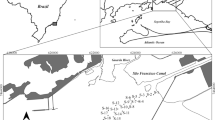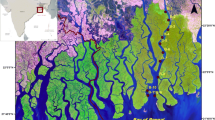Abstract
Surface sediments from Nile Delta coast were analyzed for texture, CaCO3, organic matter, fractionation, and acid leachable metals (Cr, Fe, Mn, Ni, Pb, and Zn). The distribution pattern of acid leachable heavy metals in the sediment follows the sequence: Fe>Mn>Pb>Zn>Ni>Cr. All the acid leachable metals didn’t exceed the sediment quality guidelines values (effects range low (ERL) and effects range medium (ERM)) and therefore doesn’t represent a danger to marine organisms. The correlation of acid leachable Fe, Ni, and Mn indicates a similarity in the association of metals of similar origin. The negative correlation of sand with acid leachable Cr, Fe, Ni, Pb, and Zn indicates that these elements can be easily released by ion exchange processes due to the electrostatic interaction of trace metals as they are weakly bound and is bioavailable to the liquid phase. The acid leachable Cr, Pb, and Zn indicate their association with the CaCO3, while acid leachable Fe, Mn, and Ni are hardly combined with carbonates. All the contents of acid leachable metals are negatively correlated or uncorrelated with OM, which indicates that the studied heavy metals are hardly combined with OM. The results of the partitioning study showed that the residual form was the dominant fraction of the Cr, Fe, and Ni among most of the studied locations. Among the non-lithogenic fractions, the Fe-Mn oxy-hydroxide is the main scavenger for all metals. In terms of risk assessment code (RAC) value, a decrease order in environmental risk by heavy metals was Pb>Mn>Zn>Ni>Cr>Fe. Although the results of the two techniques were not consistent with each other in terms of predicting the metals bioavailablity, a combination of total metal concentrations, acid leachable metals, and sequential extraction analysis is necessary to acquire the comprehensive information on the baseline, anthropogenic input, and bioavailability of heavy metals.





Similar content being viewed by others
References
Agemian, H., & Chau, A. S. Y. (1976). Evaluation of extraction technique for the determination of metals in aquatic sediments. Analyst, 101, 761–767.
Baruah, T. C., & Barthakur, H. P. (1997). A textbook of soil analysis. New Delhi: Vikas Publishing House, Pvt. Ltd.
Black, C. A. (1965). Methods of soil analysis, part 2, chemical and microbiological properties. Madison: American Society of Agronomy Inc.
Dang, T. C., & Jeffrey, P. O. (2006). Metal speciation in coastal marine sediments from Singapore using a modified BCR sequential extraction procedure. Applied Geochemistry, 21, 1335–1346.
Davidson, C. M., Ferreira, P. C. S., & Ure, A. M. (1999). Fresenius' Journal of Analytical Chemistry, 363, 446.
Dickinson, W. W., Dunbar, G. B., & McLeond, H. (1996). Heavy metal history from cores in Wellington Harbour, New Zealand. Environmental Geology, 27, 59–69.
EEAA (Egyptian Environmental Affairs Agency) (2009). National circumstances. Egypt Second National Communication on Climate Change.
Folk, R. L. (1974). Petrology of sedimentary rocks. Austin: Hemphill Pub. Co.
Forstner, U. (1985). In Chemical methods for assessing bioavailable metals in sludges. Lechsber, R., Davis, R. A., Hermitte, P. L. (Eds.), London: Elsevier.
Förstner, U., & Wittmann, G. (1979). Metal pollution in the aquatic environment (p. 486). Berlin-Heidelberg-New York: Springer-Verlag.
Hamza, W. (2009). The Nile Delta. In H. J. Dumont (Ed.), The Nile: Origin, environments, limnology and human use. Netherland: Springer Science & Business Media.
Horowitz, A. J. (1991). A primer on trace metal—Sediment chemistry (2nd ed., p. 136). Chelsea: Lewis Publisher.
Hu, G., Yu, R., & Zhao, J. (2011). Distribution and enrichment of acid leachable heavy metals in the intertidal sediments from the Quanzhou Bay, southeast coast of China. Environmental Monitoring and Assessment, 173, 107–116.
Hu, D., He, J., Lu, C., Ren, L., Fan, Q., Wang, J., & Xie, Z. (2013). Distribution characteristics and potential ecological risk assessment of heavy metals (Cu, Pb, Zn, Cd) in water and sediments from Lake Dalinouer, China. Ecotoxicology and Environmental Safety, 93, 135–144.
Ip Carman, C. M., Li, X. D., Zhang, G., Wai, O. W. H., & Li, Y. S. (2007). Trace metal distribution in sediments in the Pearl River Estuary and the surrounding coastal area, South China. Environmental Pollution, 147, 311–323.
Iwegbue, C. M. A., Nwajeia, G. E., Eguavoenb, O., & Ogalac, J. E. (2009). Chemical fractionation of some heavy metals in soil profiles in vicinity of scrap dumps in Warri, Nigeria. Chemical Speciation & Bioavailability, 21, 99–110.
Jain, C. K. (2004). Metal fractionation study on bed sediments of River Yamuna, India. Water Research, 38, 569–578.
Jayaprakash, M., Jonathan, M. P., Srinivasalu, S., Muthuraj, S., Ram-Mohan, V., & Rajeshwara-Rao, N. (2007). Acid leachable trace metals in sediments from an industrialized region (Ennore Creek) of Chennai City, SE coast of India: an approach towards regular monitoring. Estuarine, Coastal and Shelf Science, 22, 1–12.
Jayaprakash, M., Viswam, A., Gopal, V., Muthuswamy, S., Kalaivanan, P., Giridharan, L., & Jonathan, M. P. (2014). Bioavailable trace metals in micro-tidal Thambraparani estuary, Gulf of Mannar, SE Coast of India. Estuarine, Coastal and Shelf Science, 146, 42–48.
Jonathan, M. P., Ram-Mohan, V., & Srinivasalu, S. (2004). Geochemical variations of major and trace elements in recent sediments, off the Gulf of Mannar, the southeast coast of India. Environmental Geology, 45, 466–480.
Kaiser, M. F., Aboulela, H. A., El-Serehy, H. A., Ezz El-Din, H. (2012). Heavy metals contamination of a Mediterranean coastal ecosystem, eastern Nile delta, Egypt. International perspectives on global environmental change. Dr. Stephen Young (Ed.), ISBN: 978-953-307-815-1, InTech.
Leivouri, M. (1998). Heavy metal contamination in surface sediments in the Gulf of Finland and comparison with the Gulf of Bothnia. Chemosphere, 36(1), 43–59.
Liu, H., Li, L., Yin, C., & Shan, B. (2008). Fractionation distribution and risk assessment of heavy metals in sediments of Moushui Lake. Journal of Environmental Sciences, 20, 390–397.
Long, E. R., Macdonald, D. D., Smith, S. L., & Calder, F. D. (1995). Incidence of adverse biological effects within ranges of chemical concentrations in marine and estuarine sediments. Environmental Management, 19, 81–97.
Meguellati, M., Robbe, D., Marchandise, P., Astruc, M. (1983). In Proc. Int. Conf. on Heavy metals in the environment. Heidelberg CEP Consultants: Edinburgh, p. 1090.
Morillo, J., Usero, I., & Gracia, I. (2004). Heavy metal distribution in marine sediments from the southwest coast of Spain. Chemosphere, 55(3), 431–442.
Nguyen, H.T., Ohtsubo, M., Li, L., Higashi, T., Kanayama, M. (2010). Heavy metal characterization and leachability of organic matter rich river sediments in Hanoi, Vietnam. International Journal of Soil, Sediment and Water, 3(1), Art. 5 ISSN: 1940–3259.
Oregioni, B., Aston, S. R. (1984). Determination of selected trace metals in marine sediments by flame/flameless atomic absorption spectrophotometer. IAEA Monaco Laboratory Internal Report. Now cited in reference method in pollution studies No. 38, UNEP, 1986.
Passos, E., Alves, J., dos Santos, I., Alves, J., Garcia, C., & Spinola Costa, A. (2010). Assessment of trace metals contamination in estuarine sediments using a sequential extraction technique and principal component analysis. Microchemical Journal, 96(1), 50–57.
Perin, G., Craboledda, L., Lucchese, M., Cirillo, R., Dotta, L., Zanette, M., Orio, A. (1985). Heavy metals speciation in the sediments of Northern Adriatic Sea a new approach for environmental toxicity determination. In Lekkas, T.D. (Ed.), Heavy metals in the environment, vol. 21, pp. 454–456.
Poulton, D. J., Morris, W. A., & Coakley, J. P. (1996). Zonation of contaminated bottom sediments in Hamilton Harbour as defined by statistical classification techniques. Water Quality Research Journal of Canada, 31(3), 505–528.
Rath, P., Panda, U. C., Bhatta, D., & Sahu, K. C. (2009). Use of sequential leaching, mineralogy, morphology and multivariate statistical technique for quantifying metal pollution in highly polluted aquatic sediments—a case study: Brahamani and Nandirarivers, India. Journal of Hazardous Materials, 163, 632–644.
Rauret, G. (1998). Extraction procedures for the determination of heavy metals in contaminated soil and sediment. Talanta, 46, 449–455.
Rui-lian, Y., Xing, Y., Yuan-hui, A., Gong-ren, H., & Xian lin, T. (2008). Heavy metal pollution in intertidal sediments from Quanzhou By, China. Journal of Environmental Sciences, 20, 664–669.
Selvaraj, K., Ram-Mohan, V., & Szefer, P. (2004). Evaluation of metal contamination in coastal sediments of the Bay of Bengal, India: Geochemical and statistical approaches. Marine Pollution Bulletin, 49, 174–185.
Sestini, G. (1990). Impacts of global climate change in the Mediterranean region: responses and policy options. In Titus, J. G. (Ed.), Changing climate and the coast, Volume 2: Western Africa, the Americas, the Mediterranean Basin, and the Rest of Europe (pp. 115–125).
Sundaray, S. K. (2007). Water quality assessment of Mahanadi River, Orissa, India using multivariate statistical approach. Doctoral Thesis, Utkal University, Bhubaneswar, India.
Taliadouri, F. V. (1995). A weak acid extraction method as a tool for the metal pollution assessment in surface sediments. Mikrochimica Acta, 119(3–4), 243–249.
Tessier, A., Campbell, P. G. C., & Biason, M. (1979). Sequential extraction procedure for speciation of particulate trace metals. Journal of Analytical Chemistry, 51, 844–851.
Tuzen, M. (2003). Determination of trace metals in the River Yesilirmak sediments in Tokat, turkey using sequential extraction procedure. Microchemical Journal, 74, 105–110.
Zakir, H. M., & Shikazono, N. (2011). Environmental mobility and geochemical partitioning of Fe, Mn, Co, Ni and Mo in sediments of an urban river. Journal of Environmental Chemistry and Ecotoxicology, 3, 116–126.
Zhang, J., Huang, W. W., & Martin, J. M. (1988). Trace metal distribution in Hunghe (Yellow river). Estuarine, Coastal and Shelf Science, 26, 499–516.
Compliance with ethical standards
This paper complies with ethical standards
Author information
Authors and Affiliations
Corresponding author
Rights and permissions
About this article
Cite this article
Nasr, S.M., Soliman, N.F., Khairy, M.A. et al. Metals bioavailability in surface sediments off Nile delta, Egypt: Application of acid leachable metals and sequential extraction techniques. Environ Monit Assess 187, 312 (2015). https://doi.org/10.1007/s10661-015-4548-9
Received:
Accepted:
Published:
DOI: https://doi.org/10.1007/s10661-015-4548-9




